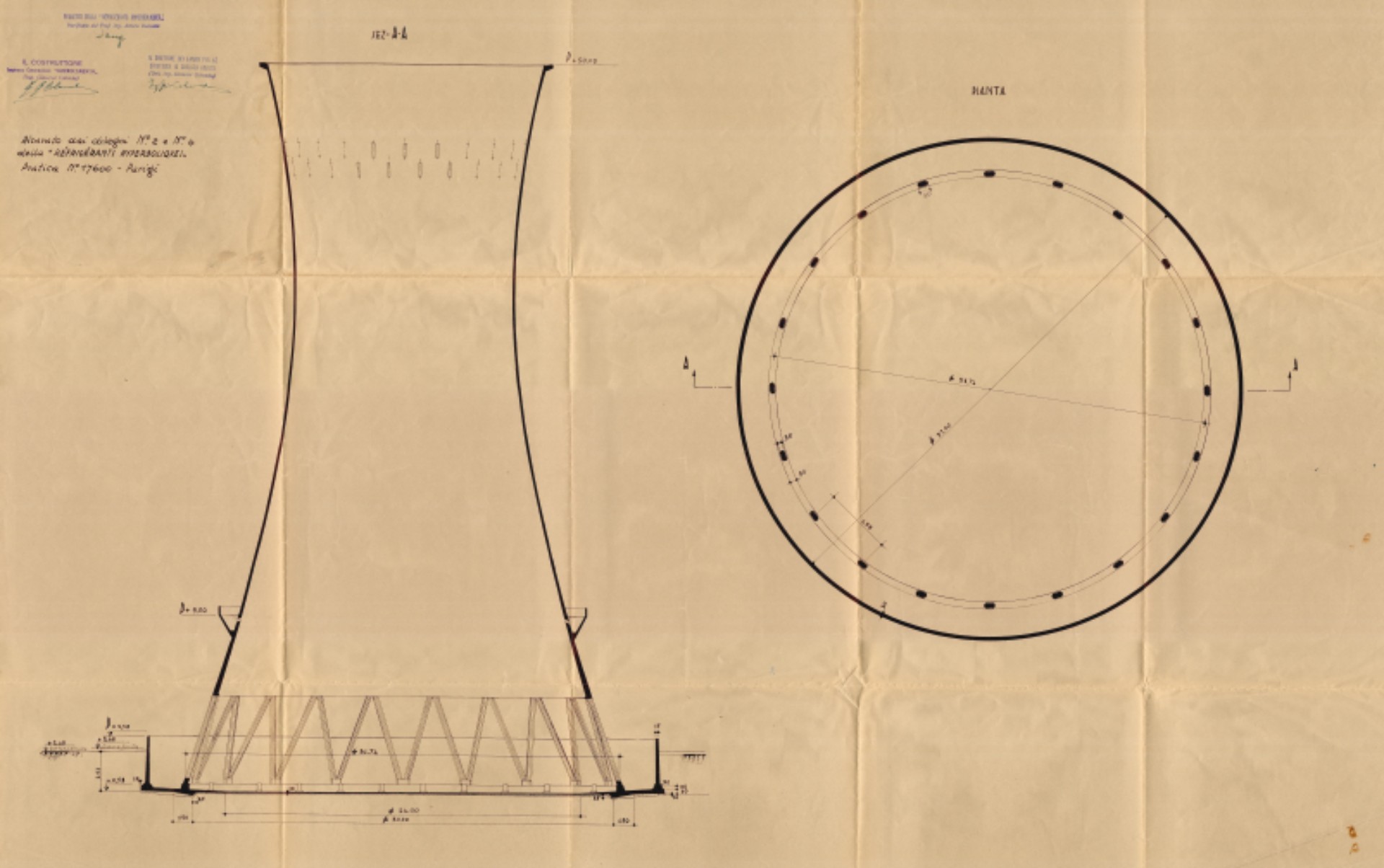
An architectural and engineering masterpiece:
the Réfrigerant Hyperbolique.
What is an object completely empty inside, built in 1938, over 53 meters tall and with a base diameter of 28? Looking at it, it seems like a building, but it is actually an ingenious oversized device. "Hyperbolic refrigerant," two words in the title of the construction drawings, help us understand its shape and function, elements that are strongly linked in this case.
"Refrigerant" allows us to describe its function: the tower was used to reduce the temperature of the production machinery's cooling liquid. In fact, the hot water, sprayed in the lower part of the tower, partially evaporated in contact with the cooler air from the pillared area, producing the characteristic cloud of water vapor at the top.
"Hyperbolic" refers to the shape. The tower is, from a geometric point of view, a hyperbolic hyperboloid, that is, a single-sheet surface with a circular base. Although it shares circular horizontal sections with cylinders and cones, this surface, which may appear bizarre to some, can be obtained by rotating a hyperbola around a vertical axis, or by rotating any line in space – called the generator – around the same axis.
The use of a hyperbolic generator for the shape is a purely 20th-century idea: the Russian engineer Vladimir Shukhov (1853-1939), intrigued by the mechanical properties of the hyperboloid, used it to build a 310-meter-tall steel radio tower. Mechanical engineer Frederik van Iterson (1877-1957) then applied the same shape to reinforced concrete to cool industrial liquids. His idea, promptly patented in 1917, is truly brilliant: the use of that shape offers significant advantages for its function. Applications then expanded to English, German, and French areas. "Our" tower is of French origin, as noted in a reference on the project drawings derived from "practice n° 17600 – Paris" for Refrigerants hyperboloques.
We are therefore inside an extraordinary work for ingenuity and realization. First of all, for its structural implications: the Marghera tower, 54.22 meters high, has a thickness varying between 10 and 35 centimeters, with excellent mechanical performance comparable, in terms of thickness, to an eggshell. This means significantly reducing the use of concrete, making the work economically sustainable. The tower then has a narrowing that leads to a 16-meter diameter, called the throat section, located 31 meters high, which improves the "chimney" effect by increasing the air speed inside the tower and ensuring better performance than cylindrical towers of the same size. The analysis of the construction project and the current state finally highlights an incredible precision of realization for such an unusual structural form, with a maximum deviation of 5 centimeters, testifying to the remarkable construction capabilities of the Italian construction industry of the time.
Symbol of capability
Constructive
Its complex hyperboloid shape construction represents a constructive masterpiece. Built without modern tools, it deviates from the perfection of the mathematical equation by only 3 cm at 40 meters height. Thanks to the unique structure of its reinforced concrete hyperboloid, it is considered an icon of Venetian industrial archaeology.
Engineering
The industrial architecture of the tower preserves and conveys the high testimonial value of the engineering capabilities of the time, representing the history and skyline of "Dock A" since its construction. Of the 5 similar structures built at the time, this hyperboloid remains the only example left. It has been the subject of surveys and studies in its multiple structural-functional-formal components by the Faculty of Engineering at the University of Padua and is taken as a scientific model for a hopeful cataloging of the entire Venetian industrial archaeology heritage.
Innovative, patented, and linguistic
The quantity and quality of patents made in different languages and countries that brought Marghera to be known worldwide reveal the capabilities of the time in terms of innovation and language skills, which serve as an example and inspiration for new generations.
Aesthetic
Besides the functionality of the structure, the former Cooling Tower constitutes a hyperboloid with a perfectly symmetrical architectural design both in its horizontal sections and around its vertical axis, elegant and light, delicately resting on its tips in a large surrounding water basin.
Sustainable
The former Cooling Tower, a cast-in-place reinforced concrete structure built in 1938, represents an example of an architectural model realized with a logic of sustainability and durability over time.
Environment- friendly
Since its inception, it has enabled the operation of large industrial plants by simply cooling water and recycling it in a closed circuit with the utmost respect for the environment.
A "capacity condenser" available to businesses, professionals, professors, etc. to aim, through the new generations, to reach the levels when Venice Marghera was recognized worldwide solely for the quality of its products and for Venice Marghera the world was the "market" of reference.

